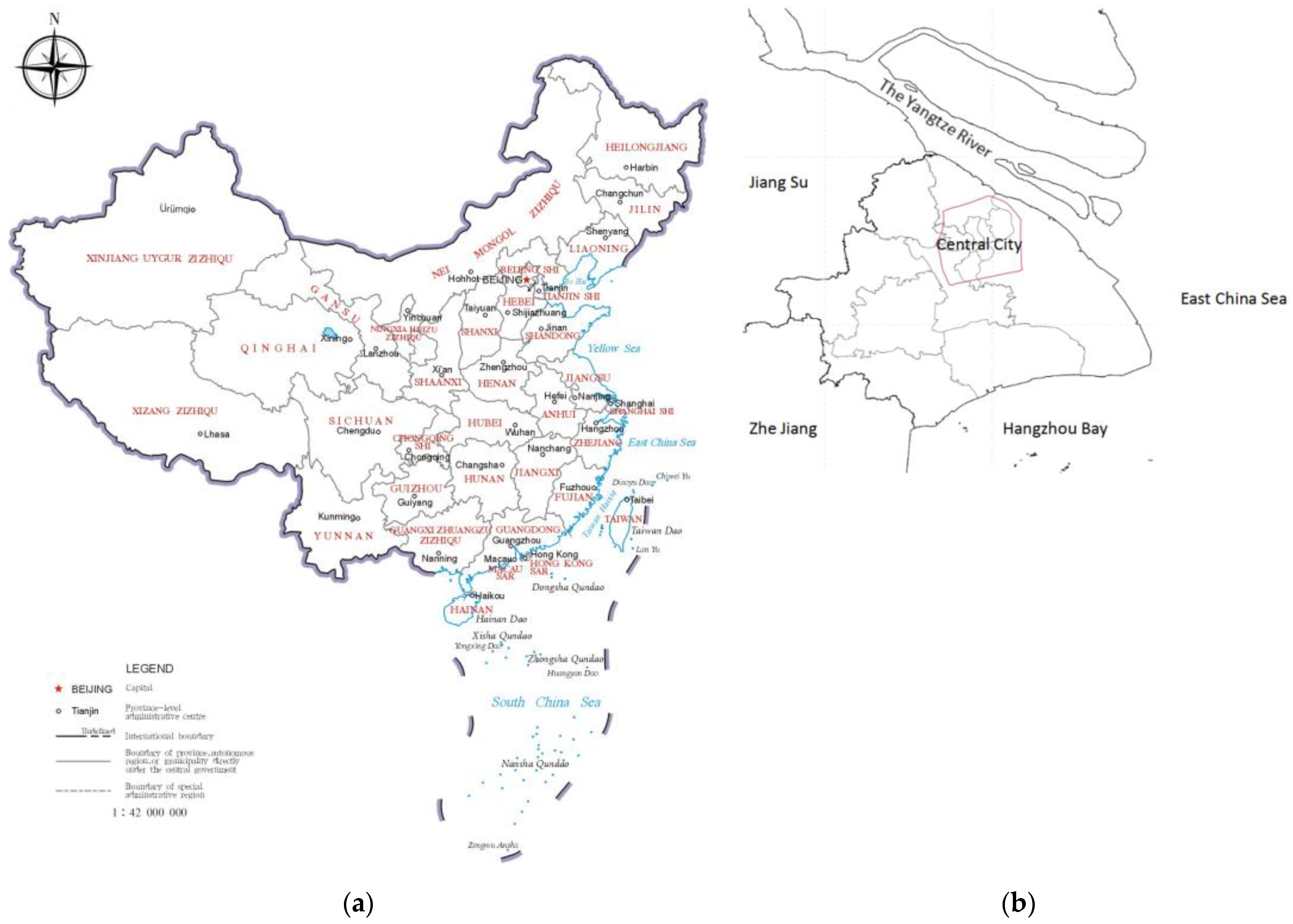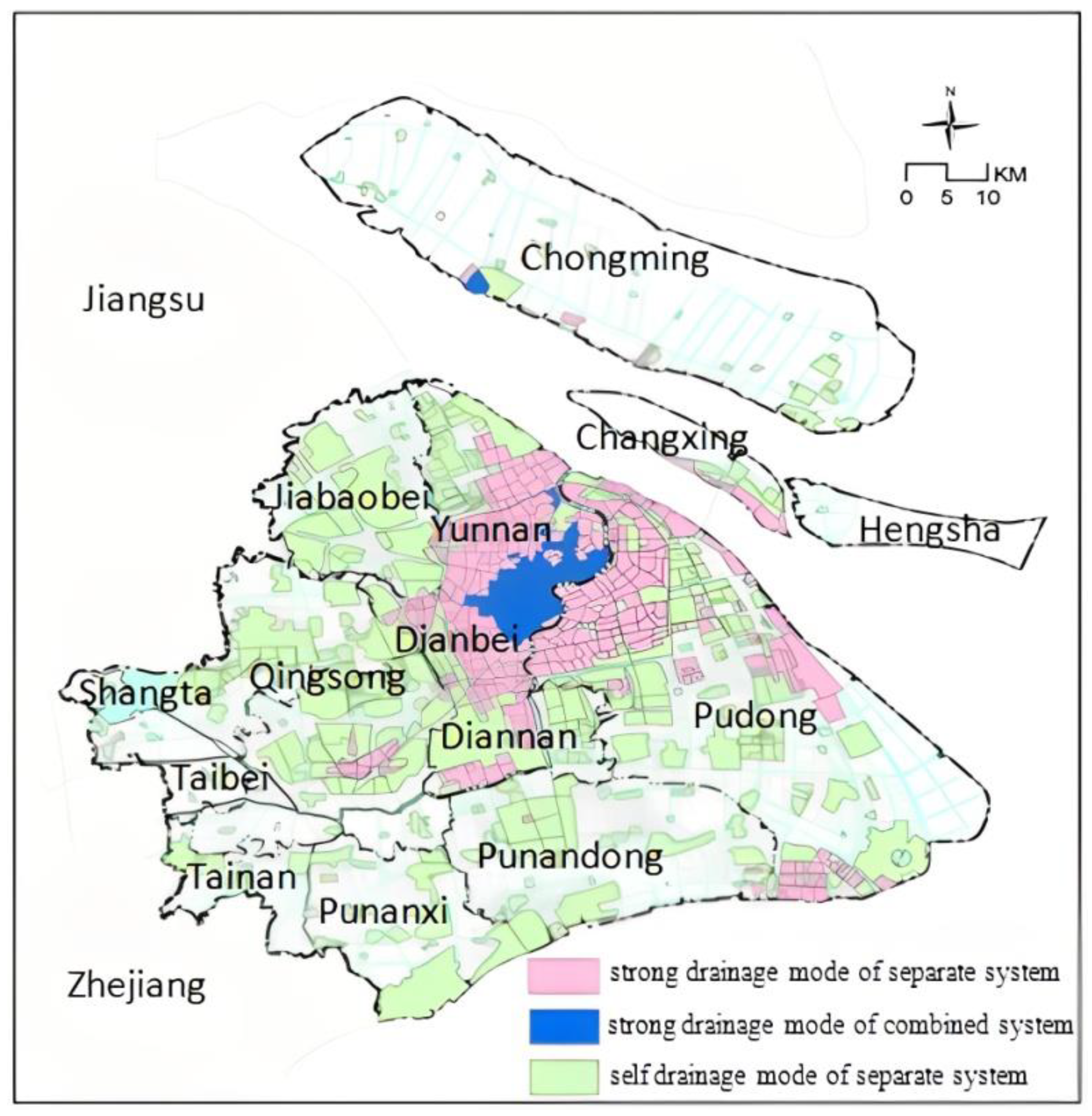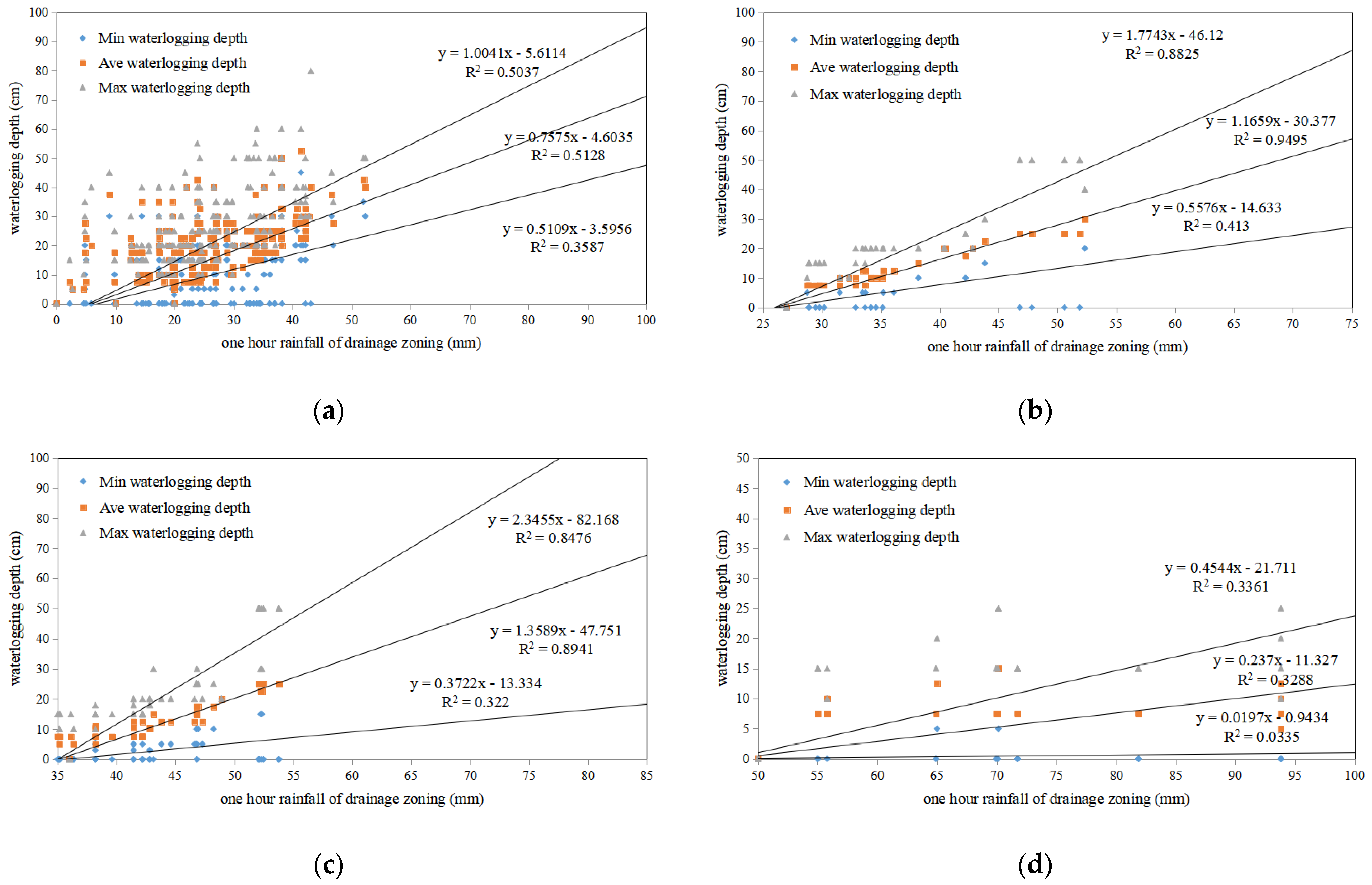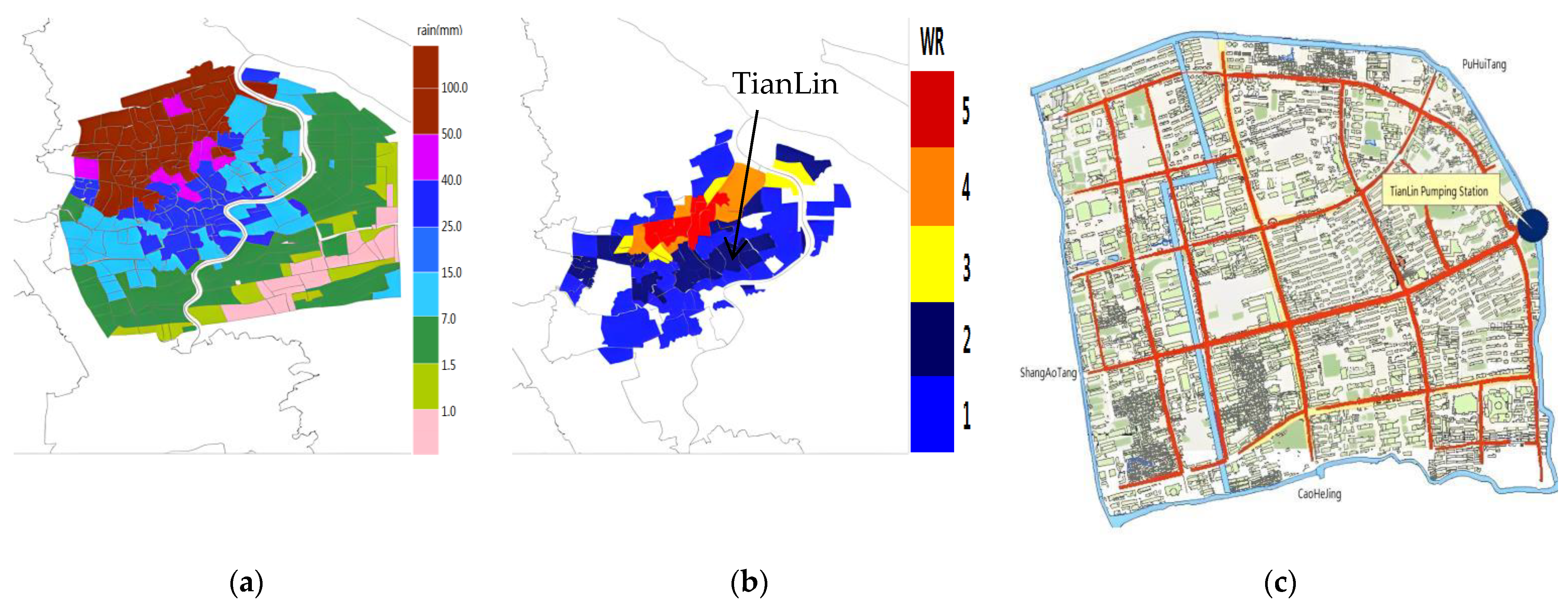The Rain-Induced Urban Waterlogging Risk and Its Evaluation: A Case Study in the Central City of Shanghai
Abstract
1. Introduction
2. Materials and Methods
2.1. The Case-Study City and Concerns
2.2. Methods
2.2.1. Drainage Area Zoning and Drainage Capacity of the Central City
2.2.2. Meteorological Data and Waterlogging Depth Data
2.2.3. Pre-Processing of the Historical Data
3. Model Setup and Prediction
3.1. Waterlogging Depth Model Concerned about Rainfall and Drainage
3.2. Setup of Rain-Induced Urban Waterlogging Risk Model
3.3. Waterlogging Risk Prediction
4. Results
4.1. Prediction Performance Evaluation
4.2. The Performance of a Heavy Rain Case Evaluation
4.3. Practice on Drainage Decision-Making Support by Waterlogging Risk Prediction
4.4. Discussions
4.5. Policy Recommendations
5. Conclusions
- (1)
- The results show that waterlogging is closely linked with rain and drainage, and waterlogging depth has a linear relationship with rainfall and drainage capacity. That is to say, more rainfall leads to higher waterlogging risk, especially in the central city with imperfect drainage facilities.
- (2)
- Rain-induced urban waterlogging risk model can rapidly give the waterlogging rank caused by rainfall with a clear classification collection. The results of waterlogging risk prediction indicate that it is confident to get the urban waterlogging risk rank well and truly in advance with more accurate rainfall prediction.
- (3)
- Information with urban waterlogging risk gives the public, policy makers and relevant departments of urban operation timely adjust their routine and emergent management who are hoping to diminish traffic intensity and personal safety. In urban construction and development processes, more attention to the improvement of drainage capacity will lead to less waterlogging risk.
Author Contributions
Funding
Data Availability Statement
Acknowledgments
Conflicts of Interest
References
- Liang, P.; Ding, Y. The Long-Term Variation of Extreme Heavy Precipitation and Its Link to Urbanization Effects in Shanghai during 1916–2014. Adv. Atmos. Sci. 2017, 34, 321–334. [Google Scholar] [CrossRef]
- Wang, X.; Yin, Z.; Wang, X.; Tian, P.; Huang, Y. A Study on Flooding Scenario Simulation of Future Extreme Precipitation in Shanghai. Front. Earth Sci. 2018, 12, 834–845. [Google Scholar] [CrossRef]
- Zhang, H.; Yang, Z.; Cai, Y.; Qiu, J.; Huang, B. Impacts of Climate Change on Urban Drainage Systems by Future Short-Duration Design Rainstorms. Water 2021, 13, 2718. [Google Scholar] [CrossRef]
- Yu, H.; Zhao, Y.; Fu, Y.; Li, L. Spatiotemporal Variance Assessment of Urban Rainstorm Waterlogging Affected by Impervious Surface Expansion: A Case Study of Guangzhou, China. Sustainability 2018, 10, 3761. [Google Scholar] [CrossRef]
- Quan, R.; Liu, M.; Lu, M.; Zhang, L.; Wang, J.; Xu, S. Waterlogging Risk Assessment Based on Land Use/Cover Change: A Case Study in Pudong New Area, Shanghai. Environ. Earth Sci. 2010, 61, 1113–1121. [Google Scholar] [CrossRef]
- Billot, R.; Faouzi, N.; Sau, J.; De Vuyst, F. Integrating the Impact of Rain into Traffic Management: Online Traffic State Estimation Using Sequential Monte Carlo Techniques. Transp. Res. Rec. 2010, 2169, 141–149. [Google Scholar] [CrossRef]
- Tran, D.; Xu, D.; Dang, V.; Alwah, A.A.Q. Predicting Urban Waterlogging Risks by Regression Models and Internet Open-Data Sources. Water 2020, 12, 879. [Google Scholar] [CrossRef]
- Islam, M.R.; Raja, D.R. Waterlogging Risk Assessment: An Undervalued Disaster Risk in Coastal Urban Community of Chattogram, Bangladesh. Earth 2021, 2, 151–173. [Google Scholar] [CrossRef]
- Zhang, Q.; Wu, Z.; Zhang, H.; Dalla Fontana, G.; Tarolli, P. Identifying Dominant Factors of Waterlogging Events in Metropolitan Coastal Cities: The Case Study of Guangzhou, China. J. Environ. Manag. 2020, 271, 110951. [Google Scholar] [CrossRef]
- Liang, Y.; Wang, Y.; Zhao, Y.; Lu, Y.; Liu, X. Analysis and Projection of Flood Hazards over China. Water 2019, 11, 1022. [Google Scholar] [CrossRef]
- Han, J.; Baik, J.; Lee, H. Urban Impacts on Precipitation. Asia-Pac. J. Atmos. Sci. 2014, 50, 17–30. [Google Scholar] [CrossRef]
- Lau, W.; Kim, K.; Ruby Leung, L. Changing Circulation Structure and Precipitation Characteristics in Asian Monsoon Regions: Greenhouse Warming vs. Aerosol Effects. Geosci. Lett. 2017, 4, 28. [Google Scholar] [CrossRef] [PubMed]
- Tian, J.; Zhang, Z.; Ahmed, Z.; Zhang, L.; Su, B.; Tao, H.; Jiang, T. Projections of precipitation over China based on CMIP6 models. Stoch. Environ. Res. Risk Assess. 2021, 35, 831–848. [Google Scholar] [CrossRef]
- Xu, S.; Wang, J.; Shi, C.; Yan, J. Research of the Natural Disaster Risk on Coastal Cities. Acta Geogr. Sin. 2016, 61, 127–138. [Google Scholar] [CrossRef]
- Hu, H. Spatiotemporal Characteristics of Rainstorm-Induced Hazards Modified by Urbanization in Beijing. J. Appl. Meteorol. Climatol. 2015, 54, 1496–1509. [Google Scholar] [CrossRef]
- Shi, J.; Cui, L. Characteristics of High Impact Weather and Meteorological Disaster in Shanghai, China. Nat. Hazards 2012, 60, 951–969. [Google Scholar] [CrossRef]
- Wu, X.; Yu, D.; Chen, Z.; Wilby, R.L. An Evaluation of the Impacts of Land Surface Modification, Storm Sewer Development, and Rainfall Variation on Waterlogging Risk in Shanghai. Nat. Hazards 2012, 63, 305–323. [Google Scholar] [CrossRef]
- Liu, Y.; Liu, Y.; Zheng, J.; Chai, F.; Ren, H. Intelligent Prediction Method for Waterlogging Risk Based on AI and Numerical Model. Water 2022, 14, 2282. [Google Scholar] [CrossRef]
- Ma, B.; Wu, Z.; Wang, H.; Guo, Y. Study on the Classification of Urban Waterlogging Rainstorms and Rainfall Thresholds in Cities Lacking Actual Data. Water 2020, 12, 3328. [Google Scholar] [CrossRef]
- Liu, F.; Liu, X.; Xu, T.; Yang, G.; Zhao, Y. Driving Factors and Risk Assessment of Rainstorm Waterlogging in Urban Agglomeration Areas: A Case Study of the Guangdong-Hong Kong-Macao Greater Bay Area, China. Water 2021, 13, 770. [Google Scholar] [CrossRef]
- Yang, Y.; Pan, C.; Fan, G.; Tian, M.; Wang, J. A New Urban Waterlogging Simulation Method Based on Multi-Factor Correlation. Water 2022, 14, 1421. [Google Scholar] [CrossRef]
- Chen, Z.; Li, K.; Du, J.; Chen, Y.; Liu, R.; Wang, Y. Three-Dimensional Simulation of Regional Urban Waterlogging Based on High-Precision DEM Model. Nat. Hazards 2021, 108, 2653–2677. [Google Scholar] [CrossRef]
- Liu, J.; Shao, W.; Xiang, C.; Mei, C.; Li, Z. Uncertainties of Urban Flood Modeling: Influence of Parameters for Different Underlying Surfaces. Environ. Res. 2020, 182, 108929. [Google Scholar] [CrossRef] [PubMed]
- Jiang, W.; Yu, J. Impact of Rainstorm Patterns on the Urban Flood Process Superimposed by Flash Floods and Urban Waterlogging Based on a Coupled Hydrologic–Hydraulic Model: A Case Study in a Coastal Mountainous River Basin within Southeastern China. Nat. Hazards 2022, 112, 301–326. [Google Scholar] [CrossRef]
- Wu, J.; Sha, W.; Zhang, P.; Wang, Z. The Spatial Non-Stationary Effect of Urban Landscape Pattern on Urban Waterlogging: A Case Study of Shenzhen City. Sci. Rep. 2020, 10, 7369. [Google Scholar] [CrossRef] [PubMed]
- Fletcher, T.; Andrieu, H.; Hamel, P. Understanding, Management and Modelling of Urban Hydrology and Its Consequences for Receiving Waters: A State of the Art. Adv. Water Resour. 2013, 51, 261–279. [Google Scholar] [CrossRef]
- Su, B.; Huang, H.; Li, Y. Integrated Simulation Method for Waterlogging and Traffic Congestion under Urban Rainstorms. Nat. Hazards 2016, 81, 23–40. [Google Scholar] [CrossRef]
- Kong, F.; Sun, S.; Lei, T. Understanding China’s Urban Rainstorm Waterlogging and Its Potential Governance. Water 2021, 13, 891. [Google Scholar] [CrossRef]
- Gu, L.; Zhao, K.; Zhang, S.; Zheng, X. An AMSR-E Data Unmixing Method for Monitoring Flood and Waterlogging Disaster. Chin. Geogr. Sci. 2011, 21, 666–675. [Google Scholar] [CrossRef]
- Zhang, S.; Pan, B. An Urban Storm-Inundation Simulation Method Based on GIS. J. Hydrol. 2014, 517, 260–268. [Google Scholar] [CrossRef]
- Cheng, S.; Wang, R. An Approach for Evaluating the Hydrological Effects of Urbanization and Its Application. Hydrol. Process. 2002, 16, 1403–1418. [Google Scholar] [CrossRef]
- Liu, P.; Wei, Q.; Lin, Z.; Lv, W. Optimized Schemes of “Infiltration”, “Storage”, and “Drainage” Measures against Urban Waterlogging in Plain River Network Regions. Water 2022, 14, 1381. [Google Scholar] [CrossRef]
- Yin, J.; Zhang, Q. A Comparison of Statistical Methods for Benchmarking the Threshold of Daily Precipitation Extremes in the Shanghai Metropolitan Area during 1981–2010. Theor. Appl. Climatol. 2015, 120, 601–607. [Google Scholar] [CrossRef]
- Shen, S.; Xu, Y. Numerical Evaluation of Land Subsidence Induced by Groundwater Pumping in Shanghai. Can. Geotech. J. 2011, 48, 1378–1392. [Google Scholar] [CrossRef]
- Wu, M.; Wu, Z.; Ge, W.; Wang, H.; Shen, Y.; Jiang, M. Identification of Sensitivity Indicators of Urban Rainstorm Flood Disasters: A Case Study in China. J. Hydrol. 2021, 599, 126393. [Google Scholar] [CrossRef]
- Singh, S.K.; Pandey, A.C.; Rathore, V.S.; Nathawat, M.S. Evaluating Factors Responsible for Contrasting Signature of Wasteland Development in Northern and Southern Ganga Plains (Bihar State, India) with Focus on Waterlogging. Arab. J. Geosci. 2014, 7, 4175–4190. [Google Scholar] [CrossRef]
- Shi, Y.; Shi, C.; Xu, S.; Sun, A.; Wang, J. Exposure Assessment of Rainstorm Waterlogging on Old-Style Residences in Shanghai Based on Scenario Simulation. Nat. Hazards 2010, 53, 259–272. [Google Scholar] [CrossRef]
- Lin, T.; Liu, X.; Song, J.; Zhang, G.; Jia, Y.; Tu, Z.; Zheng, Z.; Liu, C. Urban Waterlogging Risk Assessment Based on Internet Open Data: A Case Study in China. Habitat Int. 2018, 71, 88–96. [Google Scholar] [CrossRef]
- Mengjiang, W. Shanghai Flood Control Work Manual; Fudan University Press: Shanghai, China, 2018; pp. 484–486. [Google Scholar]
- Zhao, K.; Xue, M. Assimilation of Coastal Doppler Radar Data with the ARPS 3DVAR and Cloud Analysis for the Prediction of Hurricane Ike (2008). Geophys. Res. Lett. 2009, 36, L12803. [Google Scholar] [CrossRef]
- Xue, M.; Droegemeier, K.; Wong, V. The Advanced Regional Prediction System (ARPS)—A multi-scale nonhydrostatic atmospheric simulation and prediction model. Part I: Model dynamics and verification. Meteorol. Atmos Phys. 2000, 75, 161–193. [Google Scholar] [CrossRef]
- Powers, J.G.; Klemp, J.B.; Skamarock, W.C.; Davis, C.A.; Dudhia, J.; Gill, D.O.; Coen, J.L.; Gochis, D.J.; Ahmadov, R.; Peckham, S.E.; et al. The Weather Research and Forecasting Model: Overview, System Efforts, and Future Directions. Am. Meteorol. Soc. 2017, 98, 1717–1737. [Google Scholar] [CrossRef]
- Hong, S.; Dudhia, J.; Chen, S. A Revised Approach to Ice Microphysical Processes for the Bulk Parameterization of Clouds and Precipitation. Mon. Wea. Rev. 2004, 132, 103–120. [Google Scholar] [CrossRef]
- Li, J.; Chen, B.; Huang, W.; Zhang, X. Cloud Physics Initialization for Convection-Scale NWP: Scheme Improvements and ACase Study. Acta Meteor. Sinica. 2017, 75, 771–783. [Google Scholar] [CrossRef]
- Srivastava, K.; Bhardwaj, R. Assimilation of Doppler Weather Radar Data in WRF Model for Simulation of Tropical Cyclone Aila. Pure Appl. Geophys. 2014, 171, 2043–2072. [Google Scholar] [CrossRef]
- Martínez, C.; Sanchez, A.; Toloh, B.; Vojinovic, Z. Multi-Objective Evaluation of Urban Drainage Networks Using a 1D/2D Flood Inundation Model. Water Resour. Manag. 2018, 32, 4329–4343. [Google Scholar] [CrossRef]
- Seyedashraf, O.; Bottacin-Busolin, A.; Harou, J.J. Many-Objective Optimization of Sustainable Drainage Systems in Urban Areas with Different Surface Slopes. Water Resour. Manag. 2021, 35, 2449–2464. [Google Scholar] [CrossRef]
- Liu, J.; Shao, W. Simulation of Rainfall Runoff in Urban Districts. J. Hydraul. Eng. 2006, 37, 184–188. [Google Scholar] [CrossRef]
- Sisay, E.; Halefom, A.; Khare, D.; Singh, L.; Worku, T. Hydrological Modelling of Ungauged Urban Watershed Using SWAT Model. Model. Earth Syst. Environ. 2017, 3, 693–702. [Google Scholar] [CrossRef]
- Yan, X.; Xu, K.; Feng, W.; Chen, J. A Rapid Prediction Model of Urban Flood Inundation in a High-Risk Area Coupling Machine Learning and Numerical Simulation Approaches. Int. J. Disaster Risk Sci. 2021, 12, 903–918. [Google Scholar] [CrossRef]







| Zoning Name | Area (km2) | River or Lake Area (km2) | Water Gate Number | Peripheral Pump Station Discharge (m3/s) |
|---|---|---|---|---|
| Jiabaobei | 698.8 | 54.6 | 34 | 59.0 |
| Yunnan | 173.4 | 7.6 | 21 | 300.0 |
| Dianbei | 179.3 | 8.8 | 27 | 193.6 |
| Diannan | 186.8 | 14.3 | 14 | 28.0 |
| Pudong | 1976.6 | 151.1 | 40 | 90.0 |
| Ranks | Waterlogging Depth | Risk | Colour |
|---|---|---|---|
| 1 | 0 cm < depth ≤ 15 cm | slight | light blue |
| 2 | 15 cm < depth ≤ 30 cm | low | blue |
| 3 | 30 cm < depth ≤ 45 cm | moderate | yellow |
| 4 | 45 cm < depth ≤ 60 cm | high | orange |
| 5 | 60 cm < depth | severe | red |
| Date | Sites | Observed Waterlogging Risk | Predicted Waterlogging Risk |
|---|---|---|---|
| 17 June 2011 | Wuzhong Road, the Central city | 3 | 3 |
| Outer Ring Road | 3 | 2 | |
| Yishan Road, Xuhui | 1 | 1 | |
| 31 July 2011 | The Orient Sports Center, Pudong | 1 | 0 |
| 3 August 2011 | Puxi Road, Xuhui | 3 | 2 |
| Wujiaochang, Yangpu | 1 | 1 | |
| Gaoqiao, Pudong | 2 | 2 | |
| 4 August 2011 | Xinzhuang, Minhang | 3 | 3 |
| Wuzhong Road | 4 | 4 | |
| Xianxia Road | 4 | 4 | |
| Middle Ring Road | 2 | 2 | |
| 12 August 2011 | Beixinjing, Changning | 3 | 3 |
| Wujiaochang, Yangpu | 4 | 4 | |
| Huanghe Road, Huangpu | 4 | 4 | |
| 13 August 2011 | The whole central city | 1 | 1 |
Publisher’s Note: MDPI stays neutral with regard to jurisdictional claims in published maps and institutional affiliations. |
© 2022 by the authors. Licensee MDPI, Basel, Switzerland. This article is an open access article distributed under the terms and conditions of the Creative Commons Attribution (CC BY) license (https://creativecommons.org/licenses/by/4.0/).
Share and Cite
Zou, L.; Wang, Z.; Lu, Q.; Wu, S.; Chen, L.; Qin, Z. The Rain-Induced Urban Waterlogging Risk and Its Evaluation: A Case Study in the Central City of Shanghai. Water 2022, 14, 3780. https://doi.org/10.3390/w14223780
Zou L, Wang Z, Lu Q, Wu S, Chen L, Qin Z. The Rain-Induced Urban Waterlogging Risk and Its Evaluation: A Case Study in the Central City of Shanghai. Water. 2022; 14(22):3780. https://doi.org/10.3390/w14223780
Chicago/Turabian StyleZou, Lanjun, Zhi Wang, Qinjing Lu, Shenglan Wu, Lei Chen, and Zhengkun Qin. 2022. "The Rain-Induced Urban Waterlogging Risk and Its Evaluation: A Case Study in the Central City of Shanghai" Water 14, no. 22: 3780. https://doi.org/10.3390/w14223780
APA StyleZou, L., Wang, Z., Lu, Q., Wu, S., Chen, L., & Qin, Z. (2022). The Rain-Induced Urban Waterlogging Risk and Its Evaluation: A Case Study in the Central City of Shanghai. Water, 14(22), 3780. https://doi.org/10.3390/w14223780








